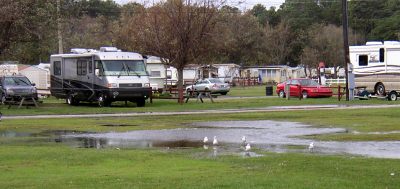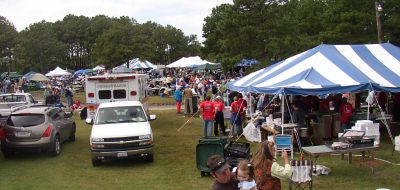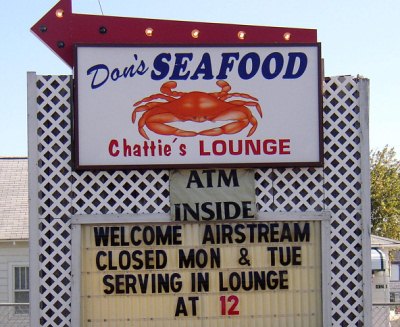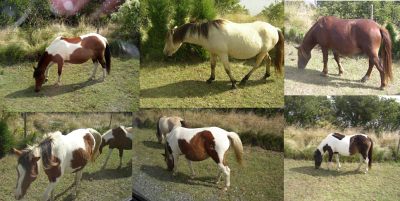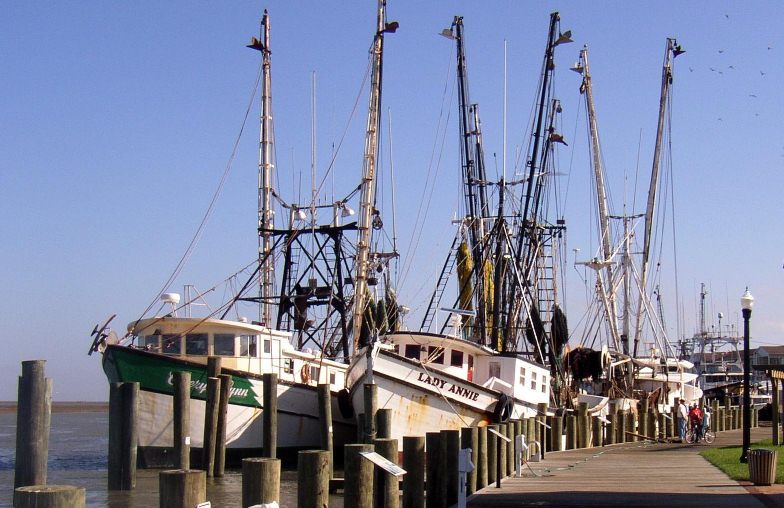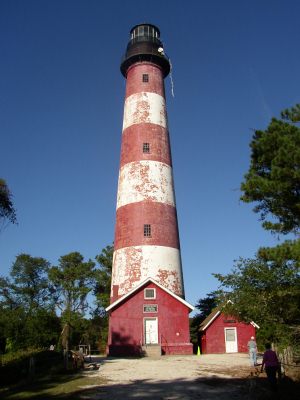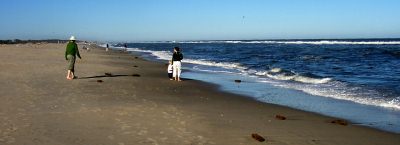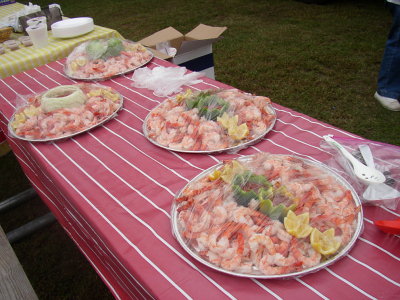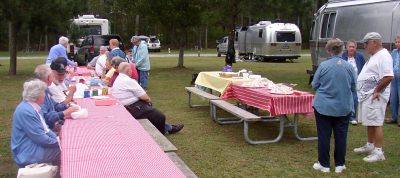October 8, 2006 - Sunshine! Good to see after all the storm clouds. Quiet and relatively secluded, Chincoteague Island is within that little piece of Virginia located on the southern tip of the Delmarva Peninsula. For years it was isolated from the rest of Virginia, reachable only by boat or by first driving through Maryland. Now the Chesapeake Bay bridge and tunnel complex at least makes it within practical driving distance. To the east is Assateague Island, most of which is either National Seashore or National Wildlfie Refuge and therefore undeveloped. Assateague is the home of the famous Chincoteague wild ponies.
Chincoteague Island has for centuries been a resource for Chesapeake Bay oysters - big business here. Other seafood is plentiful too, but this was the day for the annual Oyster Festival. Trolleys ran every twenty minutes from our campground to the festival grounds, and we were advised to use them because of limited parking at the festival. What a deal! For a flat fee ($35) you go in the gate and then pig out on seafood - no other charge. Oysters fixed every possible way, clams, crabs, hush puppies, and long lines at every booth. The shortest line was at the hot dog booth. A band playing loud music was the only entertainment, It was not just an oyster fest, it was an oyster feast. All of this was set up in a sea of mud from the recent storm.
Later in the evening there were four Joker tables playing in the activities room of the campground.
October 9, 2006 - Sunshine! and no wind! What a relief! This was a day for education and adventure. It began at Don's Seafood Restaurant in the village of Chincoteague. The restaurant was closed to the general public, so we were the only patrons. The marquee welcomed the Airstreamers. After a good meal, Don the restaurant owner told us all about another of his businesses - the aquaculture of clams. Taking clam larva from the wild, he begins with a million eggs - two thimblefuls. In two years he harvests about 300,000 mature clams. It takes a number of laborious steps in between which he explained in detail. It was all very interesting.
After lunch we drove out to Assateague Island and boarded a tour bus that took us all through the National Wildlife Refuge. The most interesting part of that two hour ride was the Chinciteague ponies. We saw 32 of the 300 wild ponies on the island - 150 on the Virginia, 150 on the Maryland side. Every year in July, the local firefighters become "saltwater" cowboys. They round up most of the ponies and swim them across the channel, run through the main street of town, then auction off all the foals. The mares and stallions are returned to the wild. The proceeds of the auction go to supporting the fire department. The foals bring an average of $1,600 each. This whole process attracts thousands of people to the island to see the action. In addition to the ponies, we saw wild turkeys, deer, geese, ducks, ibis, great white herons, snowy egrets, a host of other birds, and a unique squirrel called a Delmarva squirrel.
A bonus on the tour occurred about halfway through the 15 mile trip. A man and wife were wandering through the high grass with netting over their upper bodies. Our tour guide said they were counting butterflies. Why would anybody want to subject themselves to the hazards (primarily mosquitoes) of the marsh to count butterflies? She stopped the bus to ask. The wife came aboard the bus to explain. They were from the University of Virginia in Charlottesville studying the life cycle of the Monarch butterfly. The cycle starts in Mexico. The butterfly flies north for 2 1/2 weeks, lays its eggs, then dies. The eggs hatch and a new butterfly flies north for another 2 1/2 weeks, lays its eggs and dies. The eggs hatch and the procedure continues through four generations when the last butterfly reaches Canada. The butterfly that emerges in Canada starts flying south. Now, the same butterfly takes about 9 months to make the trip back to Mexico to start the cycle over. That southbound butterfly stops many times along the way, one place being the marsh here on Assateague Island. Teams of these people studying this life cycle visit spots all along the route counting and tagging the butterflies. Each tag - a tiny sticker - is numbered so if found later, the butterflies can be tracked. We watched this pair gather their nets and head on into the marsh taking their task seriously.
After the bus tour, we walked to the Assateague Lighthouse. This old light was built in the 1867 and has been a functioning light ever since. Tower is 142 feet high, perched on a hill that is 22 feet above sea level. The light source is three 100 watt bulbs, projected by a first order Fresnel lens. It can be seen on a clear night 20 miles at sea.
At the end of the road is the only access to the miles long beach. It requires about a quarter mile walk to reach the water at low tide. We were told that in the recent noreaster storm, the waves were breaking over the sand dunes at the inland side of the beach. On this day, the water was still rough from the storm, but there was a relatively calm area between a sand bar and the beach.
October 10, 2006 - More sunshine, clear skies, and mild temperatures. Nice! This was a free day from caravan activities, so we went looking for a laundrymat. There was no laundry on the island so we wound up in Poconoke, Maryland, 23 miles away. Back at camp, everyone broke out grills for a cookout - hamburgers and sausage - and an exchange of stories about what everyone did on their free day.
October 11, 2006 - Moving day. This time 74 miles south to the tip of the Delmarva Peninsula and the Kiptopeke State Park. This was our day to assist in parking at the new site, so we traveled early with the leaders. It rained for most of the trip, but cleared just before reaching Kiptopeke. This state park has full hookups, even cable TV. Most folks were in by mid-afternoon. At 5:30pm we had a shrimp feast on picnic tables in the park. Piles and piles of them - more than could be eaten, so most folks filled their freezers.
Kiptopeke is the southernmost village on the Delmarva Peninsula, the first community for northbound travelers after crossing the Chesapeake Bay, This state park has boat access to the bay. Many of the campers here are fishermen.


